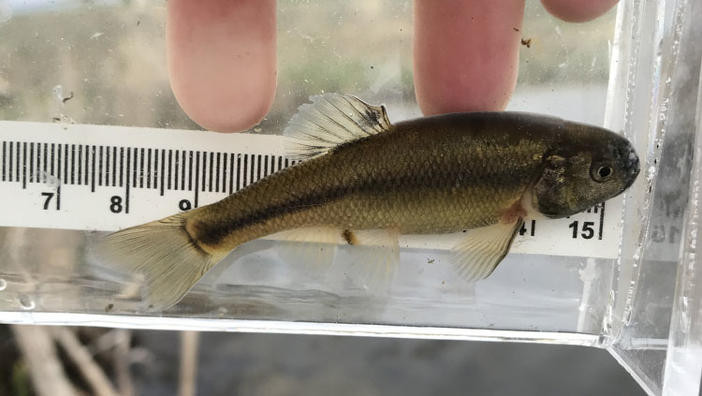Place of origin and introduction to Alberta
Rosy red minnow (Pimephales promelas) is a recently introduced fish that has potential to disrupt aquatic ecosystems and pose threats to native fish.
Rosy red minnows are a colour variation of fathead minnows bred for use as bait and as aquarium feeder fish. While fathead minnows are native in parts of Canada, including much of Alberta, rosy red minnows are potentially invasive because of their tendency to interact with the environment differently and more disruptively than their native counterparts.
Recently, rosy red minnows have been discovered in 3 locations in Alberta. They were likely introduced through intentional release of aquarium fish or from illegal live bait use.
Identification
Use keyboard or mouse to scroll through the gallery
First ray of the dorsal fin is half the length of the other rays
- 2 to 6 cm long
- Sides and belly are silver
- Back, tail and head are orange-red
- Large eyes with metallic iris
- Fins translucent
- Breeding males have white horn-like tubercles on the head
Similar species: Fathead minnow
Rosy red minnows are distinguished from native fathead minnows by their orange-red colouration.
Use keyboard or mouse to scroll through the gallery
Reproduction
- A single female can lay up to 400 eggs.
- Males guard the eggs until they hatch.
Issues
- Potential impacts are not well understood
- Evidence exists of being able to survive, overwinter and reproduce in British Columbia
- Could compete with other small fish, such as suckers, for food and habitat
- Hardy, able to survive in low oxygen waters
- Can occupy a wide variety of water types, such as streams, ponds and shallow lakes
Current management
- Prevention is the best defence as there are no selective control measures. Available response options are expensive and time consuming. Prevention is prioritized through education on responsible ownership and responsible angling in Alberta.
- When feasible, manual removal through netting and angling can be used, but is labour intensive.
- Pesticide treatment can be done as a last resort, but is often only feasible for use in isolated waterbodies where other fish are not present.
Take action
Never release aquarium fish into waterbodies. Use of live bait is illegal in Alberta. Penalties for introducing a fish into any waterbody other than where it was found can be up to $100,000 and/or a year in prison. See:
Be a responsible fish owner. If you are no longer able to take care of a fish, do not release it into the wild. Choose a responsible and humane way to end ownership:
- Contact the retailer for advice, or for a possible return/surrender.
- Give it to another aquarium owner.
- Donate it to a local aquarium society or school.
- Talk to a veterinarian about humane disposal.
Report sightings of aquatic invasive fish:
| By telephone: | Aquatic Invasive Species Hotline 1-855-336-BOAT (2628) |
| Online via mobile or desktop: | EDDMapS Alberta App |
Report any unlawful activities to:
- Report-a-Poacher phone line
1-800-642-3800 (Toll free 24 hours a day, 7 days a week)


